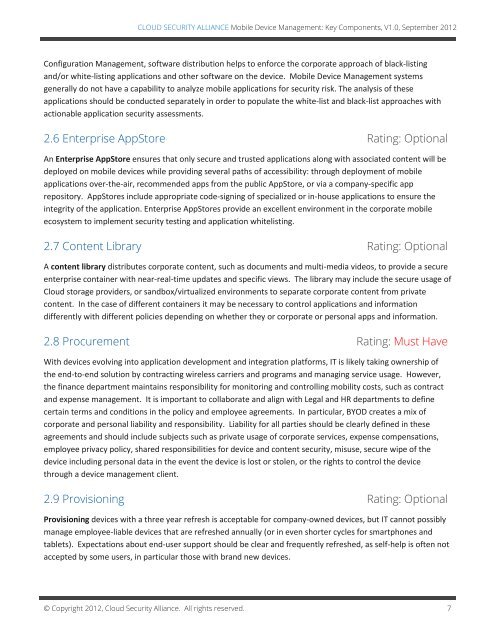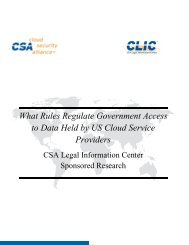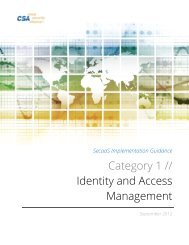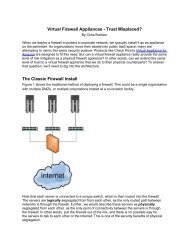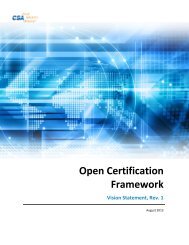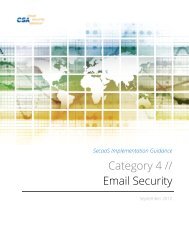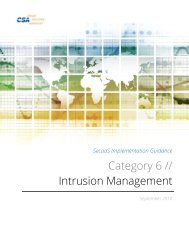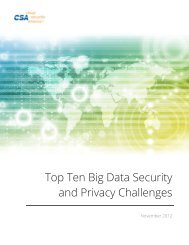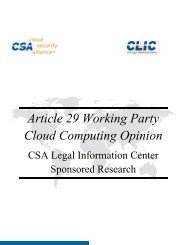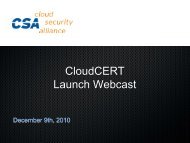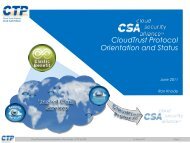Mobile Device Management: Key Components, V1.0
Mobile Device Management: Key Components, V1.0
Mobile Device Management: Key Components, V1.0
- No tags were found...
Create successful ePaper yourself
Turn your PDF publications into a flip-book with our unique Google optimized e-Paper software.
CLOUD SECURITY ALLIANCE <strong>Mobile</strong> <strong>Device</strong> <strong>Management</strong>: <strong>Key</strong> <strong>Components</strong>, <strong>V1.0</strong>, September 2012Configuration <strong>Management</strong>, software distribution helps to enforce the corporate approach of black-listingand/or white-listing applications and other software on the device. <strong>Mobile</strong> <strong>Device</strong> <strong>Management</strong> systemsgenerally do not have a capability to analyze mobile applications for security risk. The analysis of theseapplications should be conducted separately in order to populate the white-list and black-list approaches withactionable application security assessments.2.6 Enterprise AppStore Rating: OptionalAn Enterprise AppStore ensures that only secure and trusted applications along with associated content will bedeployed on mobile devices while providing several paths of accessibility: through deployment of mobileapplications over-the-air, recommended apps from the public AppStore, or via a company-specific apprepository. AppStores include appropriate code-signing of specialized or in-house applications to ensure theintegrity of the application. Enterprise AppStores provide an excellent environment in the corporate mobileecosystem to implement security testing and application whitelisting.2.7 Content Library Rating: OptionalA content library distributes corporate content, such as documents and multi-media videos, to provide a secureenterprise container with near-real-time updates and specific views. The library may include the secure usage ofCloud storage providers, or sandbox/virtualized environments to separate corporate content from privatecontent. In the case of different containers it may be necessary to control applications and informationdifferently with different policies depending on whether they or corporate or personal apps and information.2.8 Procurement Rating: Must HaveWith devices evolving into application development and integration platforms, IT is likely taking ownership ofthe end-to-end solution by contracting wireless carriers and programs and managing service usage. However,the finance department maintains responsibility for monitoring and controlling mobility costs, such as contractand expense management. It is important to collaborate and align with Legal and HR departments to definecertain terms and conditions in the policy and employee agreements. In particular, BYOD creates a mix ofcorporate and personal liability and responsibility. Liability for all parties should be clearly defined in theseagreements and should include subjects such as private usage of corporate services, expense compensations,employee privacy policy, shared responsibilities for device and content security, misuse, secure wipe of thedevice including personal data in the event the device is lost or stolen, or the rights to control the devicethrough a device management client.2.9 Provisioning Rating: OptionalProvisioning devices with a three year refresh is acceptable for company-owned devices, but IT cannot possiblymanage employee-liable devices that are refreshed annually (or in even shorter cycles for smartphones andtablets). Expectations about end-user support should be clear and frequently refreshed, as self-help is often notaccepted by some users, in particular those with brand new devices.© Copyright 2012, Cloud Security Alliance. All rights reserved. 7


